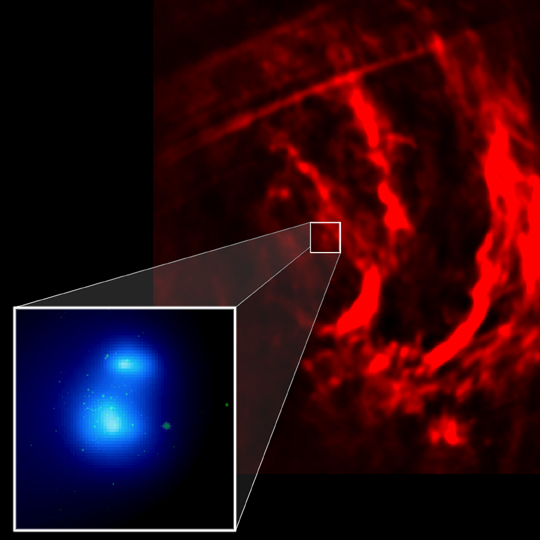
 Credit: X-ray: NASA/CXC/Northwestern/F.Zadeh et al.,
IR: NASA/HST/NICMOS, Radio: NRAO/VLA/C.Lang
Credit: X-ray: NASA/CXC/Northwestern/F.Zadeh et al.,
IR: NASA/HST/NICMOS, Radio: NRAO/VLA/C.Lang
Stellar Wind Superbubble?
Galaxies strain to produce stars. When conditions are right, and high
enough densities are reached, galaxies can produce a large number of
high-mass stars in a short space of time in a rapid burst. These
"starbursts" do violence to their hosts, since the stars they contain emit
ionizing ultraviolet radiation, and emit strong stellar winds which
interact with their surroundings. The Milky Way contains some rather
modest (by astrophysical standards) "starburst-like" regions. One
particularly beautiful example in the Milky Way is the "Arches
Cluster", a group of more than 100 massive stars which has formed near
the center of the Galaxy. The image above show large filaments seen in the
radio which give the Arches cluster its name. The inset shows a new Chandra X-ray image superposed on an
infrared image. The infrared image reveals the hot stars as pointlike
sources, while the X-ray image shows that the X-ray emission appears
unresolved to Chandra, and may be produced by a bubble of million degree
gas created by the combined powerful winds from the hot stars.
Last Week *
HEA Dictionary * Archive
* Search HEAPOW
* Education
Each week the HEASARC
brings you new, exciting and beautiful images from X-ray and Gamma ray
astronomy. Check back each week and be sure to check out the HEAPOW archive!
Page Author: Dr. Michael F.
Corcoran
Last modified June 11, 2001


